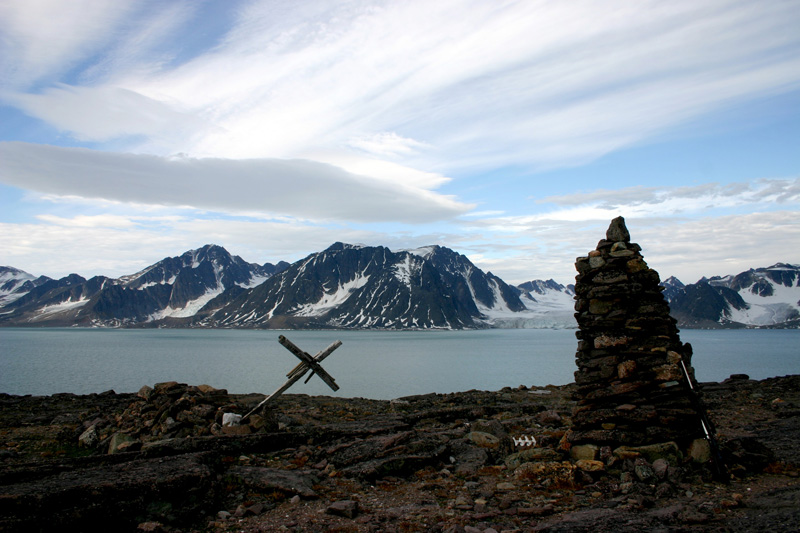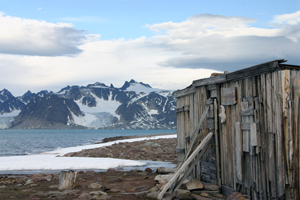Bruceneset
[79° 40' N 12° 00' E]
By Øystein Overrein (ed.), Jørn Henriksen, Bjørn Fossli Johansen, Kristin Prestvold
From the top of Brucevarden there is a stunning view over Raudfjorden’s rugged chain of mountains in the west and the red sandstone mountains in the east, after which the fjord is named. All the way up, by the cairn, is Erik Mattilas’s grave. He died of scurvy while overwintering in Raudfjorden in 1907-08.
 Mattilas’s grave and Brucevarden. (Image: Bjørn Fossli Johansen / The Norwegian Polar Institute) Take care:
- Do not touch the whaler’s grave.
- Do not touch Mattilas’s grave or the cross.
 Raudfjordhytta: the cabin in Raudfjorden. (Image: Bjørn Fossli Johansen / The Norwegian Polar Institute) Raudfjordhytta: the cabin in Raudfjorden. (Image: Bjørn Fossli Johansen / The Norwegian Polar Institute)
 A whaler’s grave between Raudfjordhytta and Brucevarden. Leave the grave in peace – do not move rocks or planks. (Image: Bjørn Fossli Johansen / The Norwegian Polar Institute) A whaler’s grave between Raudfjordhytta and Brucevarden. Leave the grave in peace – do not move rocks or planks. (Image: Bjørn Fossli Johansen / The Norwegian Polar Institute)
The bay of Alicehamna is to the east of Raudfjorden and to the south of Bruceneset. The bay has good mooring conditions and the beach is ideal as a landing place for small boats. For these reasons Alicehamna has been used by hunters, scientists and tourists for centuries, and today tour operators bring visitors ashore here.
The bay was named Alicehamna after the Princesse Alice, the ship Prince Albert I of Monaco used during his oceanographic expeditions to Svalbard from 1898 to 1907. Albert was a benefactor for a number of polar scientists, such as William S. Bruce, Fridtjof Nansen and Gunnar Isachsen, who, with the support of the Prince, was in many ways the catalyst of modern Norwegian research in Svalbard.
On the beach in Alicehamna there is a cabin known as Raudfjordhytta. It is quite recent, even though it may not look like it. In this same area there used to be a trapper’s hut dating from the period of Norwegian overwintering hunting in Svalbard. The cabin was a secondary station, built in 1927-28, by the Swede Sven Olsson. Nicknamed “Stockholms-Sven”, he was the most famous person from these hunting grounds, which stretched from Raudfjorden in the west to Velkomstpynten, on the island of Reinsdyrflya, in the east. Sven was born in Stockholm in 1884 and came to Longyearbyen in 1916. After having worked as a steward for the English at Camp Morton for a while, he started as a trapper in 1922. He spent most of his time in the north of Spitsbergen, and in the summer of 1927 he purchased the buildings by Biscayarhuken. Stockholms-Sven suffered terrible injuries to his face during an avalanche during his first winter in the mines. After that, he did not wish to show himself to people south of Longyearbyen: “A perfect capital full of comforts, said Sven, even with ladies” (Moberg, 1959:112, Ahlmann & Malmberg, 1931:286).
There is an old whaler's grave on the slope between Raudfjordhytta and Brucevarden. The coffin was once covered by stones, but the solid boards have been well preserved and are now partly visible due to frost action in the ground. A skull and other bones can be spotted between boards and the rocks that are in the stone pile. It is not known who is buried here, where he was from or when he died.
There is another grave by the cairn on Bruceneset. Both the stone pile and the well preserved cross can easily be seen on the top of the hill, and the place offers a magnificent view over fjords and mountains. The grave belongs to skipper Erik Zakariassen Mattilas, who died of scurvy in the spring of 1908 after having overwintered at the main station here in Raudfjorden together with four others.
The graves of both the whaler and Erik Zakariassen Mattilas lie in beautiful, majestic places. It is our responsibility to make sure they are both allowed to rest in peace.
Vulnerable elementsAt the whaler’s grave between the cabin and the cairn, the whaler’s cranium is visible. The cross at Mattilas’s grave has been worn by the weather. These vulnerable elements must not be touched. Landing sitesAlicehamna, by the cabin, is the most used. In case of strong wind from the south, there is an alternative mooring in the bay to the east of Bruceneset which offers shelter. Recommended trailsThere is a path from the cabin to the cairn.
Viewpoint: Brucevarden!
|